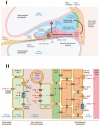Roles of Key Ion Channels and Transport Proteins in Age-Related Hearing Loss
- PMID: 34200434
- PMCID: PMC8201059
- DOI: 10.3390/ijms22116158
Roles of Key Ion Channels and Transport Proteins in Age-Related Hearing Loss
Abstract
The auditory system is a fascinating sensory organ that overall, converts sound signals to electrical signals of the nervous system. Initially, sound energy is converted to mechanical energy via amplification processes in the middle ear, followed by transduction of mechanical movements of the oval window into electrochemical signals in the cochlear hair cells, and finally, neural signals travel to the central auditory system, via the auditory division of the 8th cranial nerve. The majority of people above 60 years have some form of age-related hearing loss, also known as presbycusis. However, the biological mechanisms of presbycusis are complex and not yet fully delineated. In the present article, we highlight ion channels and transport proteins, which are integral for the proper functioning of the auditory system, facilitating the diffusion of various ions across auditory structures for signal transduction and processing. Like most other physiological systems, hearing abilities decline with age, hence, it is imperative to fully understand inner ear aging changes, so ion channel functions should be further investigated in the aging cochlea. In this review article, we discuss key various ion channels in the auditory system and how their functions change with age. Understanding the roles of ion channels in auditory processing could enhance the development of potential biotherapies for age-related hearing loss.
Keywords: age-related hearing loss; aging; auditory; cochlea; deafness; hearing; inner ear; ion channels; potassium channels; presbycusis.
Conflict of interest statement
The authors declare no conflict of interest.
Figures





References
Publication types
MeSH terms
Substances
Grants and funding
LinkOut - more resources
Full Text Sources
Medical

